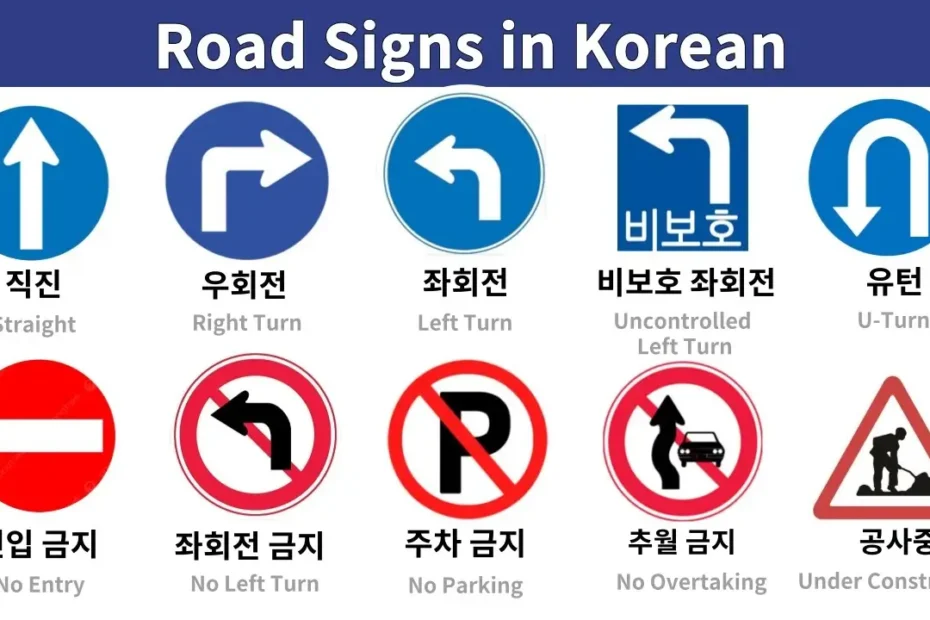🚗 Top 11 Essential Korean Driving Rules for Foreign Visitors & Hidden Road Culture Explained by Locals
1. Driving Eligibility & License
International Driving Permit (IDP) is mandatory before entering Korea. A home-country license alone is not valid.
Long-term residents (90+ days) with an Alien Registration Card (ARC) can exchange their foreign license for a Korean license.
Requirements: Passport, English driver’s license, photo, application fee.
Most rental companies require drivers to be 21+ years old with at least one year of driving experience.
Drivers under 25 may face a young driver surcharge.
Ko:Road signs in the Korea – OpenStreetMap Wiki
Road signs in South Korea – Simple English Wikipedia, the free encyclopedia
2. Traffic Lights & Road Signs
Left Turn: Only when there is a green left-turn arrow. If no “unprotected left” sign is posted, it is strictly prohibited.
U-Turns: Allowed only at designated U-turn signs with a dotted median line, often permitted when the pedestrian light is green.
Right on Red: Mandatory full stop → proceed slowly only if there are no pedestrians.
STOP signs: Rare in Korea. At alley intersections, always stop/slow down and check both ways.
Roundabouts: Vehicles already circulating have the right of way, but this is not always respected → defensive driving is key.
Traffic lights are often installed on the opposite side of intersections, which may confuse first-time drivers.
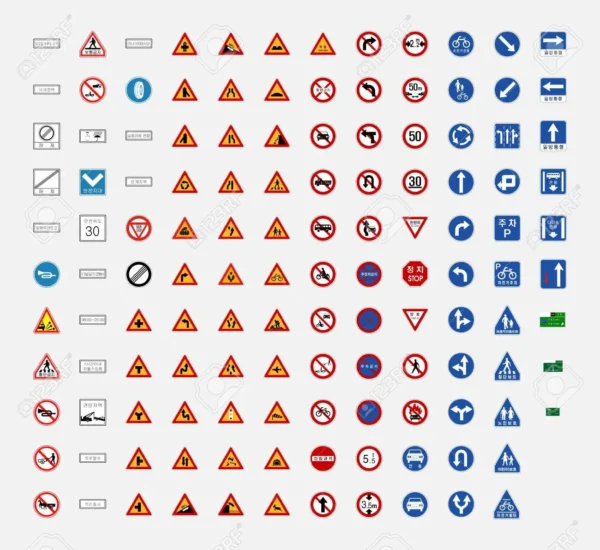
3. Lane & Road Design
The leftmost lane (1st lane) can suddenly become a left-turn-only lane → always check road arrows.
The right lane is frequently blocked by taxis, buses, or trucks stopping, disrupting flow.
Highway entry/merging lanes are short → adjust speed early.
Lane Discipline: The 1st lane is for overtaking only. Staying too long may result in a ticket.
4. Enforcement & Cameras
Korea is covered with traffic cameras: fixed, mobile, average speed check zones, and even rear-facing cameras.
Average-speed enforcement requires maintaining the limit across the entire section, not just near the camera.
Navigation apps (T-map, Kakao Map, Naver Map) are essential; they give real-time alerts for cameras and speed limits.
School zones, red-light, and illegal parking violations are strictly monitored with heavy fines.
5. Driving Manners & Culture
Using a blinker alone may not guarantee merging; sometimes you need to edge in slowly to be let in.
After being let in, flash your hazard lights 2–3 times as a thank-you gesture.
High beams mean “move aside” or a warning, not a friendly signal.
Horn use is minimal. A short beep = warning, long horn = frustration.
At unsignaled intersections, cars often move in groups (tailgating style) rather than taking turns one by one.
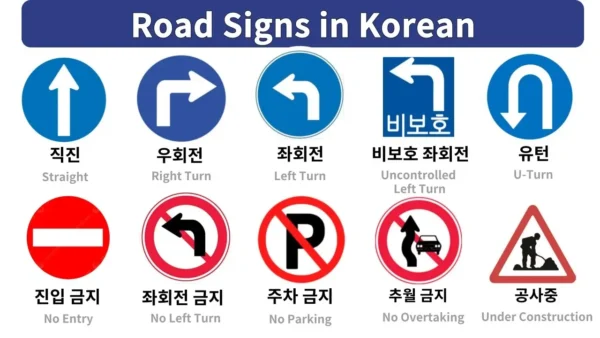
6. Parking Culture
Reverse parking (back-in parking) is the norm due to tight spaces and safer exits.
In crowded lots, turning on hazard lights means “I’m taking this spot.”
Double-parking is common; leave your phone number (often via QR code) on the dashboard.
Mechanical parking lots require folding mirrors and exact car alignment.
Valet parking is widely available in busy areas—hand over your keys and receive a ticket.
Door dings (“car door scratches”) are taken very seriously → open doors carefully.
7. Insurance & Accident Response
Always choose full coverage insurance for rentals.
In case of an accident or breakdown: call your insurance company first. Roadside service is usually fast.
Police are typically called only for personal injuries or major disputes.
Save your insurance company’s emergency number before departure.
8. School Zones & Safety Rules
School zones are 30 km/h (≈ 18 mph). If no time is specified, assume it’s 24/7.
Child seats are mandatory for kids under 6 years old.
When pedestrians have a green light, you must wait until they fully cross, regardless of lanes.
9. Driving Difficulty by Region
Seoul (Yangjae IC, Gangnam, Jongno): Heavy traffic, complex intersections, parking stress → high difficulty.
Busan city: Aggressive bus and truck driving raises the difficulty level.
Provincial roads: Lighter traffic but beware of signal violations and large trucks.
Rainy nights: Poor visibility and slippery roads make driving especially hazardous.
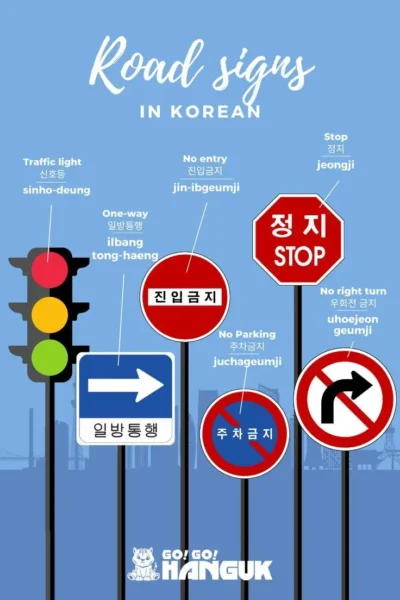
10. Navigation & Apps (Korean Driving Rules for Foreign Visitors)
T-map: Excellent for beginners, strong speed-camera alerts.
Naver Map / Kakao Map: Great for transit integration, available in English.
English addresses may not work → save Korean addresses/screenshots in advance.
Long drives: apps also show rest stops, parking info, and traffic congestion.
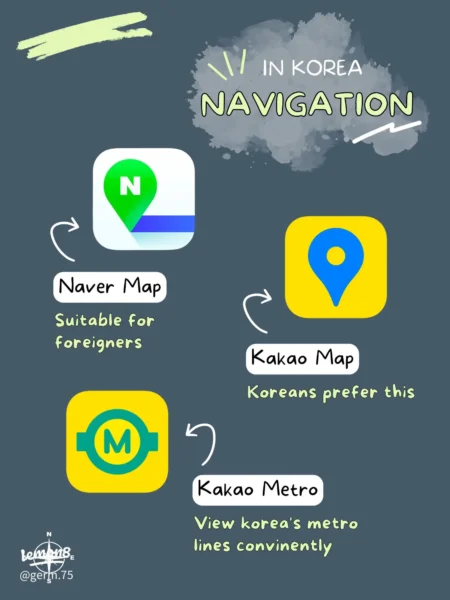
11. Payment & Everyday Tips ((Korean Driving Rules for Foreign Visitors)
Some gas stations/parking lots don’t accept foreign credit cards → carry cash, Korean card, or mobile pay apps.
At gas stations, round up the amount to the nearest 1,000 KRW for easier payment.
Most toll booths accept cards, but having a Hi-Pass device makes highway driving much smoother (details in Part 2).
✅ Pre-Drive Checklist (Korean Driving Rules for Foreign Visitors)
International Driving Permit (IDP), passport, insurance company contact info
Hi-Pass device status checked (see Part 2)
Adjust navigation voice volume (alerts are frequent)
Defensive driving mindset & lane awareness
In case of an accident → move to safety → call insurance → document with photos/videos
💡 Quick Takeaway
Driving in Korea can feel challenging due to narrow roads and strict rules, but with a navigation app, defensive driving, and cultural awareness, it’s absolutely manageable and can enrich your travel experience.
Coming Next (Part 2)
👉 Korean Highways & Rest Areas Guide: 10 Memorable Korean Highway Driving Tips | Fun Rest Area Food & Holiday Road Trip Guide 2025”
🚇 Related Reading
If you’re planning to drive in Korea, you’ll also want to master public transport.
Check out my guide: 7 Brilliant Seoul Subway Tips Locals Keep to Themselves
🚗 한국에서 운전하려는 외국인을 위한 필수 운전 규칙 & 교통 문화 (기본편 · 보강판)
1. 운전 자격 & 면허
입국 전 국제운전면허증(IDP) 발급 필수. 본국 면허증만으로는 한국에서 운전 불가.
장기 체류자(90일 이상)는 외국인 등록증 발급 후 해외 면허 → 한국 면허 교환 가능.
준비물: 여권, 영문 운전면허, 증명사진, 수수료.
대부분의 렌터카 업체는 만 21세 이상, 운전 경력 1년 이상을 요구.
만 25세 미만은 **Young Driver Surcharge(추가 요금)**이 붙을 수 있음.
2. 신호와 표지
좌회전: 전용 좌회전 신호가 있을 때만 가능. “비보호 좌회전” 표지가 없으면 절대 금지.
유턴: 반드시 유턴 표지 + 중앙선 점선이 있어야 가능. 보행자 신호가 파란불일 때 허용되는 경우가 많음.
빨간불 우회전: 일시정지 → 보행자 없는지 확인 후 서행 진입.
STOP 표지판: 한국에는 거의 없음. 대신 골목길에서는 반드시 서행·정지 후 좌우 확인.
라운드어바웃: 원칙은 회전 차량 우선이지만, 실제로는 잘 지켜지지 않는 경우도 많음 → 방어운전 필수.
신호등은 교차로 맞은편에 설치된 경우가 많아, 초행길에선 헷갈릴 수 있음.
3. 차로와 도로 설계 특징
1차선(맨 왼쪽 차로)이 갑자기 좌회전 전용으로 바뀌는 경우가 많음 → 노면 화살표 확인 필수.
우측 차로는 택시·버스 정차가 잦아 흐름이 자주 끊김.
고속도로 진입·합류 구간이 짧아 미리 속도를 맞춰야 안전.
지정차로 제도: 1차선은 추월 전용. 장시간 정속 주행 시 단속 가능.
4. 단속과 카메라
한국은 단속 카메라가 매우 많음: 고정식, 이동식, 구간단속(average speed), 후방 카메라까지 다양.
구간단속은 구간 전체 평균 속도를 계산 → 일부 구간만 속도 줄여도 소용 없음.
네비게이션(T맵, 카카오맵, 네이버지도)이 필수. 카메라 위치·속도 제한을 실시간 안내.
스쿨존, 신호위반, 불법 주정차 단속도 철저 → 과태료가 높음.
5. 운전 매너와 문화
깜빡이만 켜고 기다리면 잘 안 끼워줌 → 슬슬 밀어 넣어야 양보 받는 경우가 많음.
양보를 받으면 비상등 2~3번 깜빡 → 감사 인사 문화.
하이빔은 “양보”가 아니라 경고·비켜라 의미 → 사용 시 오해 주의.
경적은 최소화. 짧게 “띡”은 경고, 길게 누르면 불쾌함 표시.
신호 없는 사거리에서는 미국처럼 “먼저 온 차량 우선”이 아니라, 눈치껏 여러 대가 줄줄이 진입하는 경우 흔함.
6. 주차 문화
**후면주차(백 인 파킹)**이 기본. 공간이 좁고 출차 시 안전 확보 때문.
혼잡한 주차장에서는 비상등으로 “내가 들어갈 자리” 표시.
이중주차 시 대시보드에 연락처(요즘은 QR코드) 남기는 문화.
기계식 주차장은 미러 접기·차량 중앙 정렬 필수.
발레파킹(Valet Parking)도 흔하며, 키를 맡기고 영수증으로 차량 수령.
문콕 사고에 매우 민감 → 주차·문 열 때 반드시 주의.
7. 보험과 사고 대처
렌터카는 반드시 풀커버리지 보험 가입 추천.
접촉사고·고장 시 보험사 먼저 연락 → 출동 서비스가 매우 빠름.
경찰은 인명사고나 큰 분쟁일 때만 부르는 경우가 많음.
보험사 번호는 출발 전 반드시 저장해 두는 것이 안전.
8. 스쿨존 & 안전규칙
스쿨존은 시속 30km/h. 시간 제한 표기가 없으면 24시간 적용으로 이해해야 안전.
어린이 카시트는 만 6세 미만 필수.
보행자 신호가 파란불일 때는 반드시 전부 건널 때까지 정지해야 함.
9. 지역별 체감 난이도
서울(양재 IC, 강남, 종로): 교통량·도로 설계 복잡 → 난이도 매우 높음. 주차 스트레스 큼.
부산 시내: 시내버스·트럭 운행이 거칠어 체감 난이도 높음.
지방 도로: 비교적 한산하지만 신호 무시 차량·트럭 주의.
비 오는 밤: 차선 식별 어려움 + 시야 확보 힘들어 사고 위험 ↑.
10. 네비와 앱 활용
T맵: 단속 카메라 경고가 강력해 초보 운전자에게 추천.
네이버·카카오맵: 대중교통·보행 연계 강점, 영어 모드 제공.
영문 주소 인식이 약하므로 한글 주소 스크린샷 저장 필수.
장거리 여행 시 휴게소 위치·혼잡도도 네비에서 확인 가능.
11. 결제와 생활 팁
일부 주유소·주차장은 해외 신용카드 미지원 → 현금·한국 카드·모바일 결제앱 준비 필요.
주유 시 금액을 천원 단위로 맞추면 결제 편리.
고속도로 톨게이트는 대부분 카드 결제 가능하지만, 하이패스 단말기가 있으면 훨씬 편리(※ 2편에서 상세 설명 예정).
✅ 출발 전 체크리스트
국제운전면허증(IDP)·여권·보험사 연락처 확인
하이패스 단말기 여부 확인
네비게이션 음성 볼륨 조절 (과속·카메라 알림 잦음)
방어운전·차로 확인 습관 들이기
사고 시: 안전한 곳 대피 → 보험사 연락 → 사진·영상 확보
